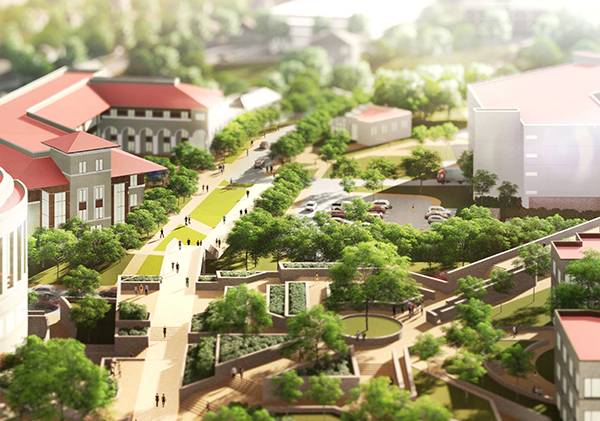Science & Engineering 'Neighborhood' sets tone for future growth
Posted by Jayme Blaschke
Office of Media Relations
November 28, 2017
With the adoption of the University Master Plan, designed to guide development through the year 2027, Texas State University has embarked on a new path of strategic growth unlike any in the university's history.
The plan, developed by the firm SmithGroupJJR of Detroit, Michigan, focuses on distinct "neighborhood" concepts to guide future redevelopment on the San Marcos Campus, the Round Rock Campus and the Science, Technology and Advanced Research (STAR) Park. These designated neighborhoods include Science and Engineering, the Hilltop and Performing Arts on the San Marcos Campus, Healthcare on the Round Rock Campus and Research and Innovation at STAR Park.

The emerging Science and Engineering Neighborhood came about in large part due to pre-existing trends at Texas State. Anchored by the Roy F. Mitte and Supple Science buildings in addition to Bruce and Gloria Ingram Hall, which is slated to open for the fall of 2018, the 11-plus acres between Comanche and Academy Streets identified in the Master Plan had already become a focal point of an interdisciplinary STEM environment. Formally designating that area the Science and Engineering Neighborhood allows the university to more effectively focus future development around a centrally-located, signature open space.
"The neighborhood concept came out of the earliest conversations we had with SmithGroupJJR at the President's Cabinet, in terms of clustering like-minded academic disciplines and research areas in certain precincts, or neighborhoods," explained Gene Bourgeois, provost and vice president for academic affairs at Texas State. "If you think about the Science and Engineering Neighborhood, the buildings, research space and instructional laboratory spaces demand certain infrastructure that isn't necessarily needed in liberal arts, humanities or College of Education buildings. From the university's perspective it's a much more cost-effective approach.
"In terms of maintenance and ongoing operations, it's certainly more efficient to have those like-minded disciplines, with their similar infrastructure needs, positioned closer together," he said. "Their electrical load, deionized water and nitrogen supply needs are much more extensive, which will be true for any new buildings we might plan to bring online in engineering and science in the future."

Upon its completion, Ingram Hall will be the largest academic building at Texas State, opening up new spaces for the Department of Biology, the Department of Mathematics and the Materials Science, Engineering and Commercialization Ph.D. program. It will also allow for the relocation and expansion of the electrical engineering, industrial engineering and manufacturing engineering programs, which will, in turn, free up space in the Roy F. Mitte Building for a new civil engineering program. Eventually, the university plans to add a mechanical engineering program.
The neighborhood concept encompasses more than just academic buildings.
“The master plan paints a broad picture for the next 10 years for physical changes at the university,” said Eric Algoe, vice president for finance and support services. “The plan includes continuing to improve pedestrian connectivity, continuing to make our campus more sustainable, renewing our underground infrastructure, changing roads to improve vehicular movement, adding and replacing residence halls, and adding more parking for our future growth.”
The 2017-2027 Master Plan also identifies potential projects beyond 2027, and identifies or preserves open space to continue growth for decades to come.
"There's an opportunity to create additional living-learning communities that would be adjacent to what then would be new academic buildings," Bourgeois said. "We could take advantage of being able to put students in residence halls, at the freshman and sophomore levels in particular, right next to or very close to their academic homes."
With the increased activity in the area, plans for the Science and Engineering Neighborhood would improve pedestrian access and safety, including the addition of a new elevated walkway over Comanche Street to improve the flow of foot traffic. Ultimately, the Department of Chemistry and Biochemistry would be relocated to this neighborhood as well, freeing up Centennial Hall and the Chemistry Building for expanded core undergraduate programs.
For more information on the Campus Master Plan, visit masterplan.fss.txstate.edu.
About Texas State University
Founded in 1899, Texas State University is among the largest universities in Texas with an enrollment of 38,849 students on campuses in San Marcos and Round Rock. Texas State’s 180,000-plus alumni are a powerful force in serving the economic workforce needs of Texas and throughout the world. Designated an Emerging Research University by the State of Texas, Texas State is classified under “Doctoral Universities: Higher Research Activity,” the second-highest designation for research institutions under the Carnegie classification system.